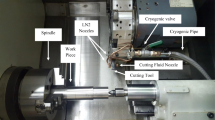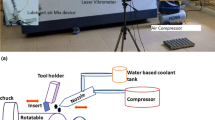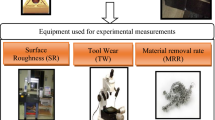Abstract
Sustainable machining necessitates energy-efficient processes, longer tool lifespan, and greater surface integrity of the products in modern manufacturing. However, when considering Ti6Al4V alloy, these objectives turn out to be difficult to achieve as titanium alloys pose serious machinability challenges, especially at elevated temperatures. In this research, we investigate the optimal machining parameters required for turning of Ti6Al4V alloy. Turning experiments were performed to optimize four response parameters, i.e., specific cutting energy (SCE), wear rate (R), surface roughness (Ra), and material removal rate (MRR) with uncoated H13 carbide inserts in the dry cutting environment. Grey relational analysis (GRA) combined with the analytic hierarchy process (AHP) was performed to develop a multi-objective function. Response surface optimization was used to optimize the developed multi-objective function and determine the optimal cutting condition. As per the ANOVA, the interaction of feed rate and cutting speed (f × V) was found to be the most significant factor influencing the grey relational grade (GRG) of the multi-objective function. The optimized machining conditions increased the MRR and tool life by 34% and 7%, whereas, reducing the specific cutting energy and surface roughness by 6% and 2% respectively. Using Taguchi-based GRA by analytic hierarchy process (AHP) weights method, the benefits of high-speed machining Ti6Al4V through multi-response optimization were achieved.








Similar content being viewed by others
Abbreviations
- AHP:
-
Analytic hierarchy process
- ANOVA:
-
Analysis of variance
- d :
-
Depth of cut
- f :
-
Feed (mm/rev)
- GRA:
-
Grey relational analysis
- GRC:
-
Grey relational coefficients
- GRG:
-
Grey relational grade
- MOO:
-
Multi-objective optimization
- MRR:
-
Material removal rate
- R :
-
Wear rate
- Ra:
-
Surface roughness
- RSM:
-
Response surface methodology
- SCE:
-
Specific cutting energy
- TOPSIS:
-
The technique for order of preference by similarity to ideal solution
- V :
-
Cutting speed
- VB:
-
Flank wear
- HSM:
-
High-speed machining
References
Tascioglu E, Gharibi A, Kaynak Y (2019) High speed machining of near-beta titanium Ti-5553 alloy under various cooling and lubrication conditions. Int J Adv Manuf Technol 102:4257–4271
Warsi SS et al (2018) Development and analysis of energy consumption map for high-speed machining of Al 6061-T6 alloy. Int J Adv Manuf Technol:1–12
Niknam SA, Khettabi R, Songmene V (2014) Machinability and machining of titanium alloys: a review. In: Davim JP (ed) Machining of Titanium Alloys. Springer Berlin Heidelberg, Berlin, Heidelberg, pp 1–30
Jaffery SHI, Khan M, Sheikh NA, Mativenga P (2013) Wear mechanism analysis in milling of Ti-6Al-4V alloy. Proc Inst Mech Eng Part B-J Eng Manuf 227(8):1148–1156
Jaffery SHI, Mativenga PT (2012) Wear mechanisms analysis for turning Ti-6Al-4V-towards the development of suitable tool coatings. Int J Adv Manuf Technol 58(5-8):479–493
Jaffery SI, Mativenga PT (2009) Study of the use of wear maps for assessing machining performance. Proc Inst Mech Eng Part B-J Eng Manuf 223(9):1097–1105
Jaffery SI, Mativenga PT (2009) Assessment of the machinability of Ti-6Al-4V alloy using the wear map approach. Int J Adv Manuf Technol 40(7-8):687–696
Jaffery SHI et al (2015) Statistical analysis of process parameters in micromachining of Ti-6Al-4V alloy. Proc Inst Mech Eng B J Eng Manuf 230(6):1017–1034
Warsi SS et al (2015) Analysis of power and specific cutting energy consumption in orthogonal machining of Al 6061-T6 alloys at transitional cutting speeds. in ASME 2015 International Mechanical Engineering Congress and Exposition. American Society of Mechanical Engineers
Mia M, Gupta MK, Lozano JA, Carou D, Pimenov DY, Królczyk G, Khan AM, Dhar NR (2019) Multi-objective optimization and life cycle assessment of eco-friendly cryogenic N2 assisted turning of Ti-6Al-4V. J Clean Prod 210:121–133
Moradnazhad M, Unver HO (2017) Energy consumption characteristics of turn-mill machining. Int J Adv Manuf Technol 91(5):1991–2016
Venugopal KA, Paul S, Chattopadhyay AB (2007) Growth of tool wear in turning of Ti-6Al-4V alloy under cryogenic cooling. Wear 262(9):1071–1078
Li W, Kara S (2011) An empirical model for predicting energy consumption of manufacturing processes: a case of turning process. Proc Inst Mech Eng B J Eng Manuf 225(9):1636–1646
Nguyen H-P, Pham V-D, Ngo N-V (2018) Application of TOPSIS to Taguchi method for multi-characteristic optimization of electrical discharge machining with titanium powder mixed into dielectric fluid. Int J Adv Manuf Technol 98(5):1179–1198
Camposeco-Negrete C (2015) Optimization of cutting parameters using response surface method for minimizing energy consumption and maximizing cutting quality in turning of AISI 6061 T6 aluminum. J Clean Prod 91:109–117
Ramesh S, Karunamoorthy L, Palanikumar K (2012) Measurement and analysis of surface roughness in turning of aerospace titanium alloy (gr5). Measurement 45(5):1266–1276
Gok A (2015) A new approach to minimization of the surface roughness and cutting force via fuzzy TOPSIS, multi-objective grey design and RSA. Measurement 70:100–109
Zhang H, Deng Z, Fu Y, Lv L, Yan C (2017) A process parameters optimization method of multi-pass dry milling for high efficiency, low energy and low carbon emissions. J Clean Prod 148:174–184
Warsi SS, Agha MH, Ahmad R, Jaffery SHI, Khan M (2019) Sustainable turning using multi-objective optimization: a study of Al 6061 T6 at high cutting speeds. Int J Adv Manuf Technol 100(1):843–855
Sarıkaya M, Güllü A (2015) Multi-response optimization of minimum quantity lubrication parameters using Taguchi-based grey relational analysis in turning of difficult-to-cut alloy Haynes 25. J Clean Prod 91:347–357
Rajemi M, Mativenga P, Jaffery S (2009) Energy and carbon footprint analysis for machining titanium Ti-6Al-4V Alloy. J Mach Eng 9(1):103–112
Mia M, Khan MA, Rahman SS, Dhar NR (2017) Mono-objective and multi-objective optimization of performance parameters in high pressure coolant assisted turning of Ti-6Al-4V. Int J Adv Manuf Technol 90(1):109–118
Escamilla-Salazar IG, Torres-Treviño LM, González-Ortíz B, Zambrano PC (2013) Machining optimization using swarm intelligence in titanium (6Al 4 V) alloy. Int J Adv Manuf Technol 67(1):535–544
Özel T, Karpat Y (2005) Predictive modeling of surface roughness and tool wear in hard turning using regression and neural networks. Int J Mach Tools Manuf 45(4-5):467–479
Shen Y, Liu Y, Dong H, Zhang K, Lv L, Zhang X, Zheng C, Ji R (2017) Parameters optimization for sustainable machining of Ti6Al4V using a novel high-speed dry electrical discharge milling. Int J Adv Manuf Technol 90(9):2733–2740
Mia M, Khan MA, Dhar NR (2017) High-pressure coolant on flank and rake surfaces of tool in turning of Ti-6Al-4V: investigations on surface roughness and tool wear. Int J Adv Manuf Technol 90(5-8):1825–1834
Mia M, Khan MA, Dhar NR (2017) Study of surface roughness and cutting forces using ANN, RSM, and ANOVA in turning of Ti-6Al-4V under cryogenic jets applied at flank and rake faces of coated WC tool. Int J Adv Manuf Technol 93(1-4):975–991
Mia M, Khan MA, Rahman SS, Dhar NR (2017) Mono-objective and multi-objective optimization of performance parameters in high pressure coolant assisted turning of Ti-6Al-4V. Int J Adv Manuf Technol 90(1-4):109–118
Kumar R, Bilga PS, Singh S (2017) Multi objective optimization using different methods of assigning weights to energy consumption responses, surface roughness and material removal rate during rough turning operation. J Clean Prod 164:45–57
Younas M et al (2019) Tool Wear Progression and its Effect on Energy Consumption in Turning of Titanium Alloy (Ti-6Al-4V). Mech Sci 10(2):373–382
Sandvik-Coromant, Product Catalogue, Turning tools. 2015.
Warsi SS, Jaffery SHI, Ahmad R, Khan M, Ali L, Agha MH, Akram S (2018) Development of energy consumption map for orthogonal machining of Al 6061-T6 alloy. Proc Inst Mech Eng B J Eng Manuf 232(14):2510–2522
ISO, I., 3685 (1993) Tool-life testing with single-point turning tools. International Organization for Standardization (ISO), Geneva, Switzerland
Pervaiz S, Deiab I, Darras B (2013) Power consumption and tool wear assessment when machining titanium alloys. Int J Precis Eng Manuf 14(6):925–936
Razak NH, Chen ZW, Pasang T (2016) Progression of tool deterioration and related cutting force during milling of 718Plus superalloy using cemented tungsten carbide tools. Int J Adv Manuf Technol 86(9):3203–3216
Cho SS, Komvopoulos K (1998) Cutting force variation due to wear of multi-layer ceramic coated tools. J Tribol 120(1):75–81
Ezugwu EO, Wang ZM (1997) Titanium alloys and their machinability—a review. J Mater Process Technol 68(3):262–274
Sun S, Brandt M, Dargusch MS (2009) Characteristics of cutting forces and chip formation in machining of titanium alloys. Int J Mach Tools Manuf 49(7):561–568
Yan J, Li L (2013) Multi-objective optimization of milling parameters – the trade-offs between energy, production rate and cutting quality. J Clean Prod 52:462–471
Kuo Y, Yang T, Huang G-W (2008) The use of a grey-based Taguchi method for optimizing multi-response simulation problems. Eng Optim 40(6):517–528
Chalisgaonkar R, Kumar J (2015) Multi-response optimization and modeling of trim cut WEDM operation of commercially pure titanium (CPTi) considering multiple user’s preferences. Eng Sci Technol, Int J 18(2):125–134
Waldorf DJ (2006) A simplified model for ploughing forces in turning. J Manuf Process 8(2):76–82
Balogun VA, Edem IF, Adekunle AA, Mativenga PT (2016) Specific energy based evaluation of machining efficiency. J Clean Prod 116:187–197
Balogun VA, Mativenga PT (2014) Impact of un-deformed chip thickness on specific energy in mechanical machining processes. J Clean Prod 69:260–268
Bahçe E, Ozel C (2013) Experimental investigation of the effect of machining parameters on the surface roughness and the formation of built up edge (BUE) in the drilling of Al 5005, in Tribology in Engineering. IntechOpen, London
Author information
Authors and Affiliations
Corresponding author
Ethics declarations
Conflict of interests
The authors declare that they have no conflict of interest.
Additional information
Publisher’s note
Springer Nature remains neutral with regard to jurisdictional claims in published maps and institutional affiliations.
Rights and permissions
About this article
Cite this article
Younas, M., Jaffery, S.H.I., Khan, M. et al. Multi-objective optimization for sustainable turning Ti6Al4V alloy using grey relational analysis (GRA) based on analytic hierarchy process (AHP). Int J Adv Manuf Technol 105, 1175–1188 (2019). https://doi.org/10.1007/s00170-019-04299-5
Received:
Accepted:
Published:
Issue Date:
DOI: https://doi.org/10.1007/s00170-019-04299-5




